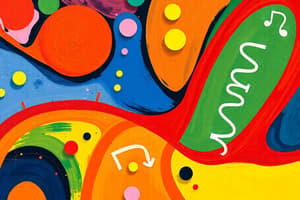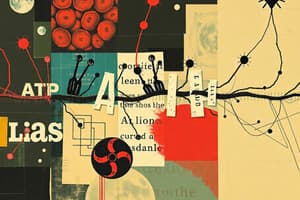Podcast
Questions and Answers
Briefly describe the role of the electron transport chain in the context of the larger metabolic pathways.
Briefly describe the role of the electron transport chain in the context of the larger metabolic pathways.
The electron transport chain uses energy from electrons to pump protons and create a proton gradient. The energy in this gradient is then harvested to produce ATP, which can be used for anabolic reactions.
Explain why both anabolic and catabolic pathways are necessary for a cell's survival.
Explain why both anabolic and catabolic pathways are necessary for a cell's survival.
Catabolic pathways break down molecules to release energy and building blocks, while anabolic pathways use energy and building blocks to synthesize new molecules. Both are required for maintaining cellular functions, growth, and response to environmental changes.
Outline the different fates of glucose within a cell, considering both anabolic and catabolic pathways.
Outline the different fates of glucose within a cell, considering both anabolic and catabolic pathways.
Glucose can be broken down for energy (glycolysis), stored as glycogen (glycogenesis), used to create 5-carbon sugars (pentose phosphate shunt), or synthesized from precursors (gluconeogenesis).
If a person is fasting and their glycogen stores are depleted, which pathway will their body primarily rely on to maintain blood glucose levels, and from what types of molecules can glucose be synthesized?
If a person is fasting and their glycogen stores are depleted, which pathway will their body primarily rely on to maintain blood glucose levels, and from what types of molecules can glucose be synthesized?
Briefly explain the relationship between glycogenesis and glycogenolysis and why both pathways are important.
Briefly explain the relationship between glycogenesis and glycogenolysis and why both pathways are important.
Distinguish between anabolism and catabolism, emphasizing the role of energy in each process.
Distinguish between anabolism and catabolism, emphasizing the role of energy in each process.
How do NADH and FADH2 contribute to ATP production, and in what part of cellular respiration are they primarily generated?
How do NADH and FADH2 contribute to ATP production, and in what part of cellular respiration are they primarily generated?
Compare and contrast glycogenesis and glycogenolysis, indicating the purpose and product of each pathway.
Compare and contrast glycogenesis and glycogenolysis, indicating the purpose and product of each pathway.
Describe the purpose of the pentose phosphate pathway (pentose phosphate shunt), and list its major products.
Describe the purpose of the pentose phosphate pathway (pentose phosphate shunt), and list its major products.
Explain how beta-oxidation contributes to energy production, including the substrate and major products of this process.
Explain how beta-oxidation contributes to energy production, including the substrate and major products of this process.
Contrast lipogenesis and lipolysis, noting the conditions under which each process is favored.
Contrast lipogenesis and lipolysis, noting the conditions under which each process is favored.
Outline the key steps of glycolysis, indicating the starting molecule, end products, and net ATP production.
Outline the key steps of glycolysis, indicating the starting molecule, end products, and net ATP production.
Explain why the breakdown of ATP to ADP + Pi releases energy.
Explain why the breakdown of ATP to ADP + Pi releases energy.
Briefly explain how the electron transport chain (ETC) contributes to the production of ATP.
Briefly explain how the electron transport chain (ETC) contributes to the production of ATP.
What is the final electron acceptor in the electron transport chain, and what molecule is formed as a result?
What is the final electron acceptor in the electron transport chain, and what molecule is formed as a result?
Explain the difference between oxidative phosphorylation and aerobic respiration.
Explain the difference between oxidative phosphorylation and aerobic respiration.
Why is oxygen essential for the electron transport chain to function? What happens if oxygen is not available?
Why is oxygen essential for the electron transport chain to function? What happens if oxygen is not available?
Briefly describe how NADH and FADH2 contribute to the ETC.
Briefly describe how NADH and FADH2 contribute to the ETC.
Explain how the pyruvate dehydrogenase complex links glycolysis to the citric acid cycle.
Explain how the pyruvate dehydrogenase complex links glycolysis to the citric acid cycle.
Describe the location of the electron transport chain (ETC).
Describe the location of the electron transport chain (ETC).
Describe the role of oxaloacetate in the citric acid cycle, and explain what happens if its levels are insufficient.
Describe the role of oxaloacetate in the citric acid cycle, and explain what happens if its levels are insufficient.
Explain the role of the H+ gradient in ATP production during the electron transport chain.
Explain the role of the H+ gradient in ATP production during the electron transport chain.
Outline the two primary metabolic fates of glucose-6-phosphate, and explain what determines which pathway is favored.
Outline the two primary metabolic fates of glucose-6-phosphate, and explain what determines which pathway is favored.
In the absence of oxygen, cells must rely on alternative pathways to produce energy. Why can't the ETC function in anaerobic conditions?
In the absence of oxygen, cells must rely on alternative pathways to produce energy. Why can't the ETC function in anaerobic conditions?
Explain how fatty acid synthesis is connected to glycolysis and the pentose phosphate pathway (PPP).
Explain how fatty acid synthesis is connected to glycolysis and the pentose phosphate pathway (PPP).
Describe the role of hormone-sensitive lipase in lipolysis and explain how its activity is regulated.
Describe the role of hormone-sensitive lipase in lipolysis and explain how its activity is regulated.
What is the direct source of energy that is used to pump H+ ions into the intermembrane space during the process of electron transport?
What is the direct source of energy that is used to pump H+ ions into the intermembrane space during the process of electron transport?
How does blocking the function of ATP synthase affect the electron transport chain and ATP production?
How does blocking the function of ATP synthase affect the electron transport chain and ATP production?
Explain the significance of carnitine in beta-oxidation of fatty acids.
Explain the significance of carnitine in beta-oxidation of fatty acids.
Describe the circumstances that lead to ketone body formation and explain why this process is important.
Describe the circumstances that lead to ketone body formation and explain why this process is important.
Explain how high levels of ATP and NADH regulate the citric acid cycle.
Explain how high levels of ATP and NADH regulate the citric acid cycle.
How does the structure of fatty acyl CoA facilitate its role in beta oxidation, and what is the significance of CoA in this process?
How does the structure of fatty acyl CoA facilitate its role in beta oxidation, and what is the significance of CoA in this process?
In the context of energy production, explain the role of acetyl CoA in linking glycolysis and the citric acid cycle (CAC).
In the context of energy production, explain the role of acetyl CoA in linking glycolysis and the citric acid cycle (CAC).
During periods of prolonged fasting, the liver converts acetyl CoA into ketone bodies. What is the purpose of this conversion, and how does it benefit other tissues in the body?
During periods of prolonged fasting, the liver converts acetyl CoA into ketone bodies. What is the purpose of this conversion, and how does it benefit other tissues in the body?
Differentiate between lipolysis and lipogenesis, indicating the substrates and products of each pathway.
Differentiate between lipolysis and lipogenesis, indicating the substrates and products of each pathway.
Explain why both fatty acid synthesis and beta-oxidation are essential pathways in cellular metabolism. What would be the consequence of a defect in either pathway?
Explain why both fatty acid synthesis and beta-oxidation are essential pathways in cellular metabolism. What would be the consequence of a defect in either pathway?
Describe the role of phospholipids and the pathway by which they are created.
Describe the role of phospholipids and the pathway by which they are created.
How are fatty acids transported from the cytoplasm into the mitochondria for beta-oxidation, and what derivative of fatty acids is involved in this transport?
How are fatty acids transported from the cytoplasm into the mitochondria for beta-oxidation, and what derivative of fatty acids is involved in this transport?
Explain the process of ketolysis and the situations in which it becomes particularly important.
Explain the process of ketolysis and the situations in which it becomes particularly important.
Besides energy production, what is one purpose of glucose metabolism, and what is the resulting product?
Besides energy production, what is one purpose of glucose metabolism, and what is the resulting product?
Which metabolic pathways are responsible for storing excess glucose and fatty acids, respectively? What are the resulting storage molecules?
Which metabolic pathways are responsible for storing excess glucose and fatty acids, respectively? What are the resulting storage molecules?
During periods of fasting, the body breaks down stored fuel. What are the pathways that break down glycogen and triglycerides called?
During periods of fasting, the body breaks down stored fuel. What are the pathways that break down glycogen and triglycerides called?
Besides glycolysis, name two metabolic pathways discussed that generate NADH.
Besides glycolysis, name two metabolic pathways discussed that generate NADH.
The liver plays a central role in supplying energy to other tissues. Which metabolic pathway is predominantly performed in the liver to supply glucose to the rest of the body?
The liver plays a central role in supplying energy to other tissues. Which metabolic pathway is predominantly performed in the liver to supply glucose to the rest of the body?
Name two pathways that result in the production of acetyl CoA. From what starting material does each pathway derive acetyl CoA?
Name two pathways that result in the production of acetyl CoA. From what starting material does each pathway derive acetyl CoA?
Acetyl CoA feeds into what energy-producing pathway? What vitamin is required to form CoA?
Acetyl CoA feeds into what energy-producing pathway? What vitamin is required to form CoA?
The electron transport chain (ETC) relies on two key energy intermediates to function. What are these intermediates, what vitamins are they derived from, and where is the ETC located?
The electron transport chain (ETC) relies on two key energy intermediates to function. What are these intermediates, what vitamins are they derived from, and where is the ETC located?
Flashcards
Anabolism
Anabolism
Metabolic pathways that build larger molecules from smaller subunits, requiring energy.
Catabolism
Catabolism
Metabolic pathways that break down larger molecules into smaller units, releasing energy.
Glycolysis
Glycolysis
A catabolic pathway that converts glucose into pyruvate, producing ATP and NADH.
ATP
ATP
Signup and view all the flashcards
NADH
NADH
Signup and view all the flashcards
FADH2
FADH2
Signup and view all the flashcards
Electron Transport Chain (ETC)
Electron Transport Chain (ETC)
Signup and view all the flashcards
Gluconeogenesis
Gluconeogenesis
Signup and view all the flashcards
Electron Transport Chain
Electron Transport Chain
Signup and view all the flashcards
Pentose Phosphate Shunt
Pentose Phosphate Shunt
Signup and view all the flashcards
Glycogenesis
Glycogenesis
Signup and view all the flashcards
Fatty Acid Synthesis
Fatty Acid Synthesis
Signup and view all the flashcards
Phospholipid Fatty Synthesis
Phospholipid Fatty Synthesis
Signup and view all the flashcards
Lipogenesis
Lipogenesis
Signup and view all the flashcards
Lipolysis
Lipolysis
Signup and view all the flashcards
Beta Oxidation
Beta Oxidation
Signup and view all the flashcards
Acetyl CoA
Acetyl CoA
Signup and view all the flashcards
Citric Acid Cycle
Citric Acid Cycle
Signup and view all the flashcards
Ketogenesis
Ketogenesis
Signup and view all the flashcards
CoA
CoA
Signup and view all the flashcards
NADH and FADH2
NADH and FADH2
Signup and view all the flashcards
Oxygen's role in ETC
Oxygen's role in ETC
Signup and view all the flashcards
Oxidative phosphorylation
Oxidative phosphorylation
Signup and view all the flashcards
ATP Synthase
ATP Synthase
Signup and view all the flashcards
Intermembrane space
Intermembrane space
Signup and view all the flashcards
Aerobic respiration
Aerobic respiration
Signup and view all the flashcards
Fatty Acids
Fatty Acids
Signup and view all the flashcards
NADH Production
NADH Production
Signup and view all the flashcards
FADH2 Production
FADH2 Production
Signup and view all the flashcards
Glycogen Metabolism
Glycogen Metabolism
Signup and view all the flashcards
Pathways Ending in Acetyl CoA
Pathways Ending in Acetyl CoA
Signup and view all the flashcards
Glycolysis to Acetyl CoA
Glycolysis to Acetyl CoA
Signup and view all the flashcards
Ketone Bodies
Ketone Bodies
Signup and view all the flashcards
Ketolysis
Ketolysis
Signup and view all the flashcards
Glycogenolysis
Glycogenolysis
Signup and view all the flashcards
Triglycerides
Triglycerides
Signup and view all the flashcards
Study Notes
Metabolism Overview
- Metabolism is the sum of all chemical reactions in the body
- Anabolism: Building complex molecules from simpler ones, requiring energy
- Catabolism: Breaking down complex molecules into simpler ones, releasing energy
Metabolic Objectives
- Define and contrast anabolism and catabolism
- List examples of direct and indirect cellular energy
- Provide the substrate(s), product(s), purpose, and cellular location for various anabolic and catabolic pathways
- Describe the electron transport chain (ETC) and its function
ATP for Energy
- ATP (adenosine triphosphate) is the primary energy currency of cells
- ATP stores energy in high-energy phosphate bonds
- Breaking these bonds releases energy used for cellular work
Catabolic Reactions
- Catabolic reactions not only produce ATP but also generate NADH and FADH₂ (indirect energy intermediates)
- These intermediates feed into the electron transport chain (ETC) to produce more ATP
Location of Metabolic Reactions
- Many catabolic reactions occur in the mitochondria
- The electron transport chain (ETC) is in the inner mitochondrial membrane, where it harnesses energy from NADH and FADH₂ to produce ATP
Glucose Pathways
- Gluconeogenesis: Makes glucose from precursors like lactate, glycerol, and amino acids
- Glycogenesis: Stores glucose as glycogen
- Glycogenolysis: Breaks down glycogen to release glucose
- Glycolysis: Breaks down glucose to pyruvate, producing some NADH and ATP
Fatty Acid Pathways
- Fatty acid synthesis: Makes fatty acids using acetyl CoA
- Lipogenesis: Stores fatty acids as triglycerides
- Lipolysis: Breaks down triglycerides to release fatty acids
- Beta-oxidation: Breaks down fatty acids for energy production via acetyl CoA
Acetyl CoA Pathways
- Citric Acid Cycle (CAC): Acetyl CoA enters the CAC to produce ATP, NADH, and FADH₂
- Ketogenesis: Liver produces ketone bodies from acetyl CoA to supply energy to other tissues
- Ketolysis: Other tissues break down ketone bodies to produce acetyl CoA, which enters the CAC
Electron Transport Chain (ETC)
- The ETC is a series of electron carriers in the inner mitochondrial membrane
- Electrons from NADH and FADH₂ are passed down the chain
- This releases energy used to pump H+ into the intermembrane space, setting up an electrochemical gradient
- The H+ gradient drives the production of ATP via ATP synthase
- Oxygen is the final electron acceptor in the ETC
Terminology
- Oxidative phosphorylation: Generation of ATP via the ETC
- Aerobic respiration: The process of breaking down glucose to produce energy via the ETC. Requires oxygen
- Anaerobic conditions: Absence of oxygen, where energy production occurs via processes other than aerobic respiration.
Self-Test Questions (and Answers)
(Answers are not provided in these notes. You need to use the lecture material to arrive at the answers)
Summary Table of Glucose and Fatty Acid Comparison (Note: incomplete table from slides, user must fill in)
| Feature | Glucose | Fatty Acids |
|---|---|---|
| Purpose | Make (Precursors), Use (5-C sugars), Store (glycogen), Break (pyruvate) | Make, Use (phospholipids), Store (triglycerides), Break (acetyl CoA) |
| Uses | ... | ... |
| Start Molecules | ... | ... |
Studying That Suits You
Use AI to generate personalized quizzes and flashcards to suit your learning preferences.
Related Documents
Description
Overview of metabolism, focusing on anabolism and catabolism. Covers ATP as the primary energy currency and the role of catabolic reactions in producing ATP, NADH, and FADH₂. Includes the function and location of the electron transport chain (ETC).




